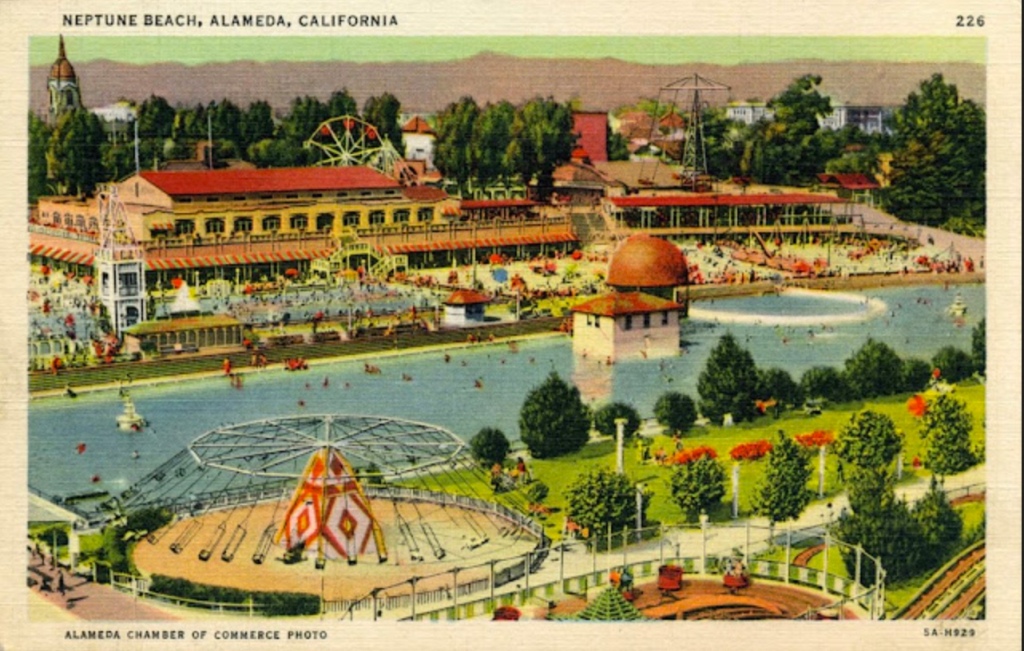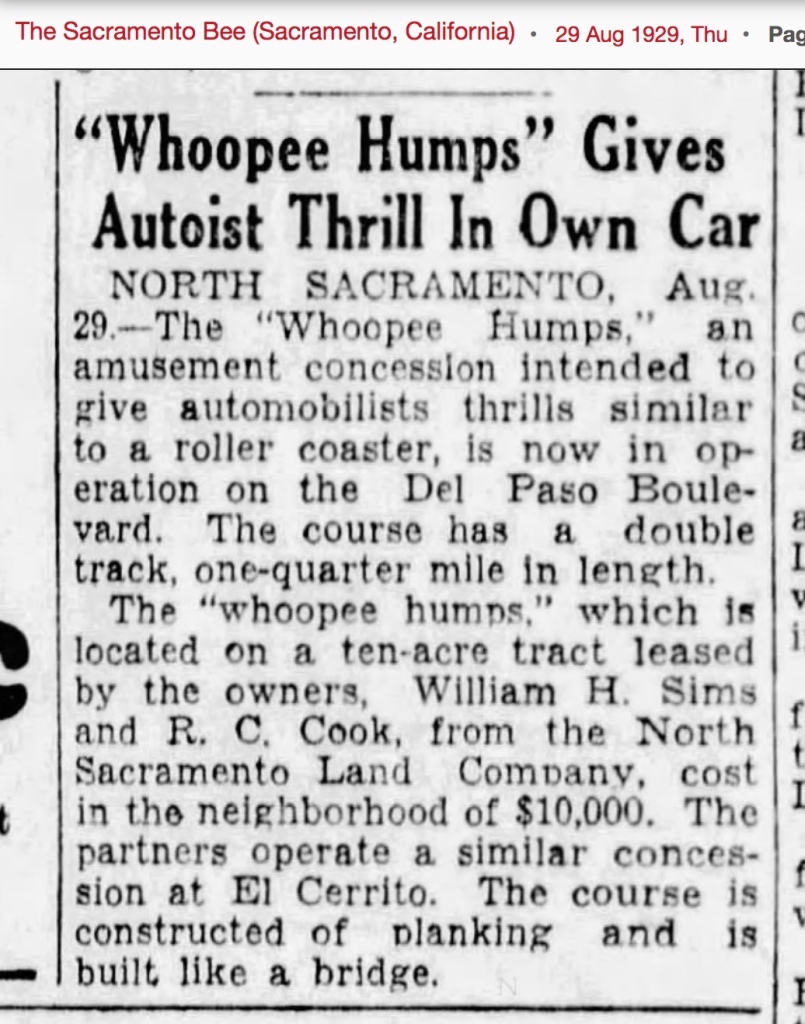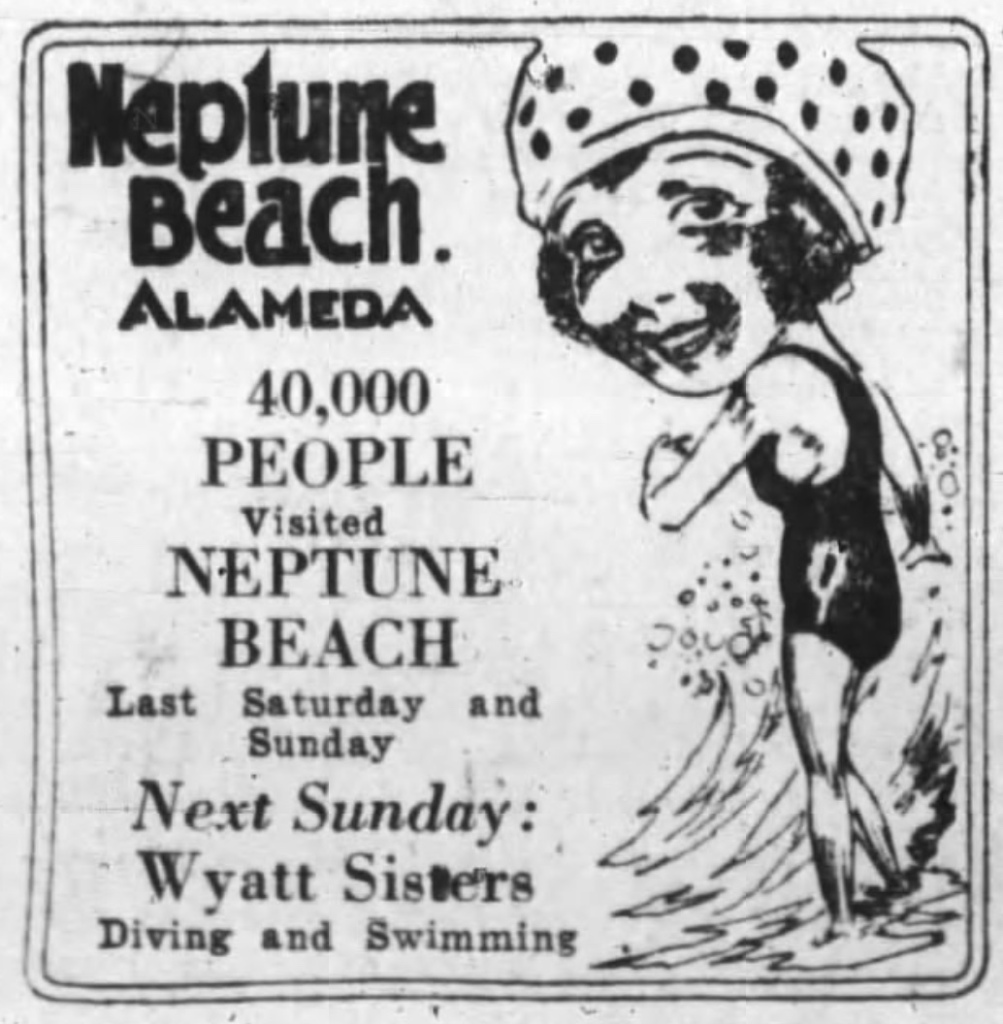In my recent release THE RED-HOT BLUES CHANTEUSE, I wrote a few delicious chapters set at Alameda, California’s late, great Neptune Beach amusement park. Here’s a little more Neptune Beach history, in a post that was initially published in
. . .
Imagine that it’s April 1919 and you’re a U.S. Army 2nd Lieutenant just returned to your home city of San Francisco. You’ve survived the Meuse–Argonne offensive in France, two brutal waves of the Spanish Influenza, a rolling troop ship across the Atlantic, and an eight-day train ride—standing room only—to the West Coast. You’ve even survived last week’s Welcome Home Parade, the three-mile march down Market Street, and your mother’s unending tear-stained hugs.
But now it’s Sunday afternoon, you’ve been a good son for four whole days (you and your parents have returned from church services), and you’re spoiling to get out and see the town. Your way.
And why wouldn’t you? San Francisco in 1919 was a glorious City by the Bay: replete with saloons, vaudeville theatres, moving picture storefronts, boxing rings, and even public baths on the Pacific Ocean.
But why stay in San Francisco at all, when in forty minutes a ferry could transport you to the shores of Neptune Beach, where there’s endless sunshine, sports, and suds of all kinds. Not to mention bathing-suited mermaids. Why, indeed?

Welcome to Neptune Beach!
Located on the bayside of the island of Alameda (just across from the city of Oakland), the Neptune Beach amusement park offered everything a visitor would want. You could dive into the competition-size swimming pool or bathe in the saltwater surf; walk the midway and win a prize at the shooting gallery; watch a boxing match; or eat breakfast, lunch, or dinner at the cafeteria.
The truly adventurous could ride the eight-story Scenic Railway roller coaster, while the milder-at-heart could ride the Ferris wheel or the hand-carved Dentzel carousel (rescued from the remains of San Francisco’s 1915 Pan Pacific International Exposition). And at night time—after changing out of your sandy bathing suit into your more formal clothes—you could dance the hours away with a local band. And then, just when you’re ready to leave, come the fireworks over the bay.
Neptune Beach was only one of dozens of small amusement parks that dotted the American landscape around World War I. You know about New York’s Coney Island, of course, and depending upon where you live you may have heard about Olentangy Park in Ohio, Palisades Amusement Park in New Jersey, and Harlem Park in Illinois. While I was researching Neptune Beach, I happily discovered the short-lived Idola Park, which was located just a few miles away from where I live today. That’s how common these small amusement parks were.
Celebrated in the Oakland Tribune as the “big Alameda bathing resort”, Neptune Beach was located at the intersection of Webster Street and Central Avenue. The resort’s elaborate, exotic tower—not to mention the Southern Pacific Railroad spur that dropped people off right in front—ensured that no one would ever miss the entrance gate.
Neptune Beach opened its gates informally in the winter of 1917 as the Oakland Tribune proclaimed, “Each Sunday and holiday the new resort is now thrown open.” Not surprisingly, nearby bathing establishments like Sunset Baths and Sunny Cove Baths quickly announced “big schemes of improvement” to be finished in time for bathing season.
But Neptune Beach was determined to make the biggest splash in the bay, and on St. Patrick’s Day 1917, the park hosted a Bal-Masque (masked balls being quite popular in the Bay Area) and pageant specifically for East Bay newspapermen. The day-to-evening event featured both athletic and aquatic entertainments with “the beach and surrounding grounds…turned into a fairyland.”
The highlight of the St. Patrick’s Day event was “an aerial demonstration and flight by Guy Colwell, Alameda aviator, who, with Florence Jones of the Hippodrome theater for a passenger (on her first flight) engaged in an air battle with Company F, National Guard of California”. As the newspaper foretold, “Machine guns, light artillery and aeroplane rifles will all figure in the sham engagement.”
The next day Neptune Beach hosted swim races offering gold, silver, and bronze medal prizes. The outdoor swimming season formally opened on Sunday April 1st with a great aquatic carnival. Forty thousand people (as the advertisement claimed) visited Neptune Beach on opening weekend.
There were other parks set on water in the Bay Area (including San Francisco’s Sutro Baths), but with direct ferries from San Francisco to Alameda and a direct rail line from the Alameda Mole to Neptune Beach, people from around the bay flocked to the park, readily paying the ten cents entrance fee.
America’s entry into World War I—a few weeks after Neptune Beach opened—did nothing to mar the amusement park’s premiere summer. Throughout 1917, beach goers enjoyed the “magnificent $500,000 new bathing beach” which was open every day of the week. Summer activities included swimming competitions between those mermaids that our returning 2nd Lieutenant was eager to meet, canoe racing, baseball games played in the surf, the jester’s palace and the ocean wave, beach slides for the kids, exhibitions by world champion swimmers Norman Ross and Frances Cowell, and a display of high diving by an artist who dove from a diving tower extension while in flames. (Here I have to offer apologies; I wasn’t able to clarify which was in flames, the artist or the diving tower.)
Neptune Beach also entertained beachgoers by holding at least one more sham battle, this one about ten days after the United States formally declared war against Germany. This battle was held “between an attacking force from the bay and land forces. Participating in the battle will be a company of National Guard, members of the Naval Reserve, cadets from Yerba Buena and several local military companies.”
At the end of October 1917 the park closed for the winter season and—except for January 1st 1918 when nine mermaids braved the 42 degree temperature to dive from the Neptune Beach steps into the bay—remained closed until March 1918.

The Spanish Influenza Epidemic of 1918 & 1919
As many of us in 2021 now know—whether we’re historians and writers of historical fiction or not—March 1918 also marked the beginning of the Spanish Influenza in America, a pandemic that had three broad waves of transmission and hospitalization in America: Spring 1918, Fall 1918, and Spring 1919.
Despite the Spanish Influenza outbreak in other parts of America, Neptune Beach opened as planned for business in April 1918. The good news is that the city of Alameda—like Oakland and San Francisco—was spared any influenza patients in the first wave of Spring 1918. The bad news is that they were not as lucky in the fall, when in September a man returning to San Francisco showed symptoms of influenza and was admitted to the city hospital.
Alameda took the second influenza wave seriously around October 19th, when the City Manager and health authorities closed “all places where crowds might congregate”. All places except Neptune Beach that is. The resort was allowed to remain open, although the dance hall was closed until further notice. The swimming tanks had already been closed by mid-October, but the rest of the attractions—the “scenic railway, merry-go-round, Ferris wheel and other amusement devices”—remained open. The Alameda Health Officer declared that “sunshine was the best preventive of the malady and that the people should be encouraged to spend their time out of doors.”
Neptune Beach became the only source of entertainment in the city, although the Oakland Tribune reported that, “while this place had a goodly crowd, the children were noticeable through their absence. Parents have been cautioned by the school board to refrain from letting the youngsters get together in neighborhood clans”.
Just before Halloween, one reporter even exclaimed that “Sunshine and salt water keep Neptune Beach patrons immune from influenza and thousands of people from the various cities about the bay are spending all of their spare time on the sand letting the rays of sun sink in. Doctors agree that fresh air is the most deadly enemy of the influenza microbe. For those recuperating from the malady there is no better place than Neptune Beach, where Old Sol is on the job daily with germ-killing rays”.

Neptune Beach closed as planned in the beginning of November 1918, and in the Bay Area, cases of influenza in the Second Wave dwindled down in January 1919. There’s no newspaper record of the nine mermaids diving back into the bay from the Neptune Beach steps on January 1st 1919.
In the Bay Area, the Spring 1919 wave of Spanish Influenza was far less severe than the Autumn 1918 wave. Accordingly, Neptune Beach opened to the public on Saturday March 29th. As recorded by the San Francisco Chronicle, the day’s events included swimming races, high diving, water polo, relay races, and a festival of mermaids. No mention of the curative powers of salt water or Old Sol were made by the reporter, a possible indication that local influenza cases were deemed to be under control.
Farewell to Neptune Beach!
Unlike many other amusement parks across America, Neptune Beach survived the let’s get-out-of-town automobile craze of the 1920’s (it actually doubled in size in 1923, and proudly added the WHOOPEE Roller Coaster later in the decade)* and the Great Depression of the 1930’s (when the resort welcomed the Lindy Loop and other new children’s’ rides).
Not even a fire in 1931 or death-by-roller-coaster in 1936 could stop the amusement park. But the opening of the San Francisco Bay Bridge in 1936—which allowed San Franciscans to explore the far reaches of Northern California in their automobiles—made it impossible for the park to survive much longer.
Neptune Beach emptied out the swimming tank and locked the gates for the last time in 1939, but the story of the “big Alameda bathing resort” is continually celebrated in Alameda.
*I can’t mention Neptune Beach’s WHOOPEE Roller Coaster without sharing this 1929 Sacramento Bee clipping about the Whoopee Humps automobile amusement concession:

Resources:
- Alameda Historical Museum (currently closed due to COVID-19) features a Neptune Beach exhibit. Join them on Facebook where you can search for Neptune Beach posts.
- Alamedainfo.com. Neptune Beach, Alameda, California, old postcards, photos and other historic images.
- East Bay Regional Park Service, Neptune Beach: Coney Island of the West
- Historic Alameda 1920-1938 on YouTube. Neptune Beach in the late 1930’s begins around 2.43.
- Oakland Tribune newspaper.
- San Francisco Examiner newspaper.



